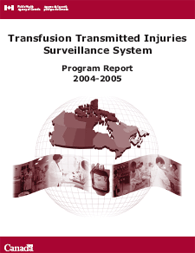Common menu bar links
Transfusion Transmitted Injuries
Surveillance System
Program Report
2004-2005
Transfusion Transmitted Injuries Section
Blood Safety Surveillance and
Health Care Acquired Infections Division
March 2008
Table of Contents
Executive Summary- Introduction
- Methodology
- Data validation at PHAC
- Data analysis
- Results
- 3.1 Adverse Transfusion Events Included for Analysis
3.2 Adverse Transfusion Events Related to Blood Components
- 3.2.1 Type of Blood Components Implicated in Adverse Transfusion Events
3.2.2 Relationship of Adverse Transfusion Events to Transfusion
3.2.3 Severity and Outcome of Adverse Transfusion Events
3.2.4 Type of Adverse Transfusion Events Related to Blood Components
3.2.5 Type of Adverse Transfusion Event by Relationship to Transfusion
3.2.6 Type of Adverse Transfusion Events by Severity
3.2.7 Analysis by Specific Type of Adverse Transfusion Event: ABO incompatibility, AHTR, DHTR, TRALI and bacterial contamination
3.2.7.1 ABO Incompatibility
3.2.7.2 Acute Hemolytic Transfusion Reactions (AHTR)
3.2.7.3 Delayed Hemolytic Transfusion Reactions (DHTR)
3.2.7.4 Bacterial Contamination
3.2.7.5 TRALI and possible TRALI
3.2.8 Incidence of Adverse Transfusion Events
3.3 Adverse Transfusion Events Related to Plasma Derivatives and
Recombinant Products
3.4 Deaths - 3.1 Adverse Transfusion Events Included for Analysis
- Discussion
4.1 Data quality
4.2 Severity of adverse transfusion events and deaths
4.3 Bacterial contamination, ABO incompatibilities, and other reactions
4.4 TRALI
4.5 TACO, DHTR, and PTP
4.6 Severe/anaphylactic/anaphylactoid reaction
4.7 Plasma derivatives
4.8 Conclusion
List of Figures
Figure 1. Proportion of Canadian transfusion activity represented by hospitals
participating in TTISS (as of 31 December, 2005)
Figure 2. Distribution of adverse transfusion events by age and gender,
2004-2005
Figure 3. Blood components involved in adverse transfusion events (N = 655),
2004-2005
Figure 4. Relationship of adverse transfusion events with transfusion of blood
components (N = 655), 2004-2005
Figure 5. Severity of adverse transfusion events related to blood components
(N = 655), 2004-2005
Figure 6. Severity of adverse transfusion events by type of blood component,
2004-2005
Figure 7. Outcome of adverse transfusion events related to blood components
(N = 655), 2004-2005
Figure 8. Severity of ABO incompatibility by type of blood component,
2004-2005
Figure 9. Severity of acute hemolytic transfusion reactions (N = 32), 2004-2005
Figure 10. Causes of acute hemolytic transfusion reactions (N = 32), 2004-2005
Figure 11. Severity of delayed hemolytic transfusion reactions (N = 45), 2004-2005
Figure 12. Antibodies implicated in delayed hemolytic transfusion reactions
(N = 45), 2004-2005
Figure 13. Adverse transfusion events involving Bacterial contamination, by
relationship to transfusion, 2004-2005
Figure 14. Severity of bacterial contamination by type of blood component,
2004-2005
Figure 15. Type of blood component implicated in TRALI (N = 105), 2004-2005
Figure 16. Severity of TRALI related to blood components (N = 105), 2004-2005
Figure 17. Rates of adverse transfusion events per 100 000 units of blood
components transfused by year, 2002-2005
Figure 18. Plasma derivatives and recombinant products related to adverse
transfusion events (N = 107), 2004-2005
Figure 19. Relationship to transfusion of adverse transfusion events related to
plasma derivatives and recombinant products (N = 107), 2004-2005
Figure 20. Severity of adverse transfusion events related to plasma derivatives and
recombinant products (N = 107), 2004-2005
List of Tables
Table 1. Units of blood components transfused by hospital sites participating
in TTISS, by year
Table 2. Adverse transfusion events reported through TTISS and other sources,
2004-2005
Table 3. Adverse transfusion events by type of products and year of
occurrence
Table 4. Type of blood components implicated in ATEs by year
Table 5. Relationship of adverse transfusion events to transfusion by type of
blood component and year
Table 6. Severity of adverse transfusion events related to blood components
by year
Table 7. Outcome of adverse transfusion events related to blood components
by year
Table 8. Type of adverse transfusion events related to blood components
by year
Table 9. Type of adverse transfusion events by relationship to transfusion,
2004-2005
Table 10. Type of adverse transfusion events by severity, 2004-2005
Table 11. Adverse transfusion events involving ABO incompatibility, by type
of blood component
Table 12. Severity of bacterial contaminations by type of organism and blood
component
Table 13. Severity by type of blood component implicated in TRALI cases
Table 14. Incidence of adverse transfusion events by blood component, 2004
Table 15. Incidence of adverse transfusion events by blood component, 2005
Table 16. Type of adverse transfusion event related to plasma derivatives and
recombinant products, 2004-2005
Table 17. Relationship of transfusion to deaths by blood product and type of
adverse transfusion reaction, 2004-2005
Table 18. Incidence of deaths by type of adverse transfusion event, 2004-2005
[next]

